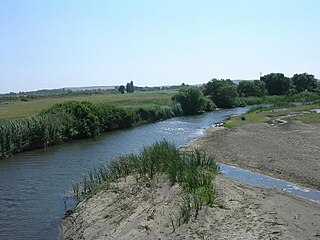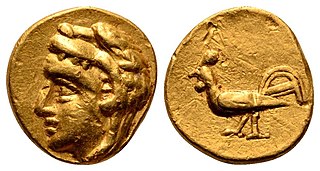
Alexandria Troas is the site of an ancient Greek city situated on the Aegean Sea near the northern tip of Turkey's western coast, the area known historically as Troad, a little south of Tenedos. It is located southeast of modern Dalyan, a village in the Ezine district of Çanakkale Province. The site sprawls over an estimated 400 hectares ; among the few structures remaining today are a ruined bath, an odeon, a theatre, gymnasium complex and a recently uncovered stadion. The circuit of the old walls can still be traced.

Strabo was a Greek geographer, philosopher, and historian who lived in Asia Minor during the transitional period of the Roman Republic into the Roman Empire.

Scamander (; also Skamandros or Xanthos was a river god in Greek mythology.
In Greek mythology, Acherusia was a name given by the ancients to several lakes or swamps, which, like the various rivers called Acheron, were at some time believed to be connected with the underworld, until at last the Acherusia came to be considered to be in the lower world itself.
Erichthonius of Dardania was a mythical king of Dardanus in Greek mythology. He was the son of Dardanus and Batea. He was the brother of Ilus and Zacynthus. Erichthonius was said to have enjoyed a peaceful and prosperous reign.

The Büyük Menderes River, is a river in southwestern Turkey. It rises in west central Turkey near Dinar before flowing west through the Büyük Menderes graben until reaching the Aegean Sea in the proximity of the ancient Ionian city Miletus. The river was well known for its sinuous, curving pattern, and gives its name to the common term used to describe these characteristic bends in rivers.

The Hermunduri, Hermanduri, Hermunduli, Hermonduri, or Hermonduli were an ancient Germanic tribe, who occupied an inland area near the source of the Elbe river, around what is now Bohemia from the first to the third century, though they have also been speculatively associate with Thuringia further north. According to an old proposal based on the similarity of the names, the Thuringii may have been the descendants of the Hermunduri. At times, they apparently moved to the Danube frontier with Rome. Claudius Ptolemy mentions neither tribe in his geography but instead the Teuriochaemae, who may also be connected to both.

Karamenderes is a river located entirely within the Çanakkale Province of Turkey. It flows west from Mount Ida and empties into the Aegean Sea near the Troy Historical National Park. According to the Iliad, the battles of the Trojan War were fought in the lower courses of Karamenderes.

Dardanus or Dardanum was an ancient city in the Troad. It was sometimes called Dardania, a term used also for the district around it. Pliny the Elder called it Dardanium. It appears in other sources indirectly as well. The city-ethnic, or appellation of a person from Dardanus, is Dardaneus. Its coin legends are DAR and DARDAN. Its localization is securely marked by an inscription naming itself on the site.
In Greek mythology, King Teucer was said to have been the son of the river-god Scamander and the nymph Idaea.

Coele-Syria alternatively Coelo-Syria or Coelosyria, was a region of Syria in classical antiquity. The term mostly referred to the "hollow" Beqaa Valley between the Lebanon and the Anti-Lebanon mountain ranges, but sometimes it was applied to a broader area of the region of Syria. The area is now part of the modern-day Syria and Lebanon.

Simoeis or Simois was a river of the Trojan plain, now called the Dümruk Su, and the name of its god in Greek mythology.

The Geographica or Geography is an encyclopedia of geographical knowledge, consisting of 17 'books', written in Greek and attributed to Strabo, an educated citizen of the Roman Empire of Greek descent. There is a fragmentary palimpsest dating to the fifth century. The earliest manuscripts of books 1–9 date to the tenth century, with a 13th-century manuscript containing the entire text.

Utik was a historic province of the Kingdom of Armenia. It was ceded to Caucasian Albania following the partition of Armenia between Sassanid Persia and the Eastern Roman Empire in 387 AD. Most of the region is located within present-day Azerbaijan immediately west of the Kura River, while a part of it lies within the Tavush province of present-day northeastern Armenia.
Thymbra or Thymbre was a town in the Troad, near Troy. The second of the six gates of Troy was named after it, according to John Lydgate. The location is about five miles from present day Hissarlik, the site of the present archaeological excavations.

Ariana was a general geographical term used by some Greek and Roman authors of the ancient period for a district of wide extent between Central Asia and the Indus River, comprising the eastern provinces of the Achaemenid Empire that covered the whole of modern-day Afghanistan, as well as the easternmost part of Iran and up to the Indus River in Pakistan. Ariana is the Latinized form of the Ancient Greek Ἀρ(ε)ιανή Ar(e)ianē, originating from the Old Persian word Ariyanem (Ariana) meaning 'the Land of the Aryans', similar to the use of Āryāvarta.
Hestiaea of Alexandria, also Hestiaea, was a scholar who wrote a treatise on Homer's Iliad that discussed the question whether the Trojan War was fought near the city then called Ilium, and which was cited by Demetrius of Scepsis. None of her work is extant.
Neandreia, Neandrium or Neandrion (Νεάνδριον), also known as Neandrus or Neandros (Νέανδρος), was a Greek city in the south-west of the Troad region of Anatolia. Its site has been located on Çığrı Dağ, about 9 km east of the remains of the ancient city of Alexandria Troas in the Ezine district of Çanakkale province, Turkey. The site was first identified as Neandreia by Frank Calvert in 1865 and Joseph Thacher Clarke in 1886 and was first excavated by the German architect Robert Koldewey when he excavated in 1889.
In Greek mythology, Ilus was the founder of the city called Ilios or Ilion to which he gave his name. When the latter became the chief city of the Trojan people it was also often called Troy, the name by which it is best known today. In some accounts, Ilus was described to have a plume of horsehair.
Scamandria or Skamandreia was a small town in the ancient Troad in ancient Mysia, no doubt situated on the Scamander River in the plain of Troy.












